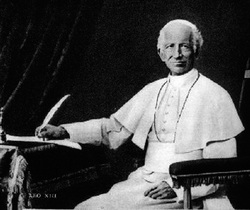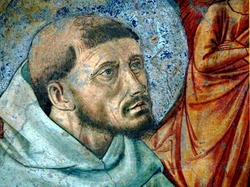 I think there is much to learn of the martyr-saint by the person who killed her. Alessandro Serenelli killed the 11 year old Maria in 1902 and then spent the rest of his life in penance until the Lord called him home on May 6, 1970.
I think there is much to learn of the martyr-saint by the person who killed her. Alessandro Serenelli killed the 11 year old Maria in 1902 and then spent the rest of his life in penance until the Lord called him home on May 6, 1970.
He spent 27 in prison (released in 1929). What I take as a prompting of the Holy Spirit, Serenelli asked for forgiveness on his knees Maria’s mother, Assunta Goretti, on Christmas night 1934. According to the world, Assunta caved. According to divine justice and mercy Assunta extended forgiveness to him because of her faith in Jesus Christ, and that on her deathbed, Maria forgave him.
In a 1961 letter found 10 years after Alessandro’s death –so in 1980– we know his thoughts:
When I was 20 years-old, I committed a crime of passion. Now, that memory represents something horrible for me. Maria Goretti, now a Saint, was my good Angel, sent to me through Providence to guide and save me. I still have impressed upon my heart her words of rebuke and of pardon. She prayed for me, she interceded for her murderer. Thirty years of prison followed.
If I had been of age, I would have spent all my life in prison. I accepted to be condemned because it was my own fault.
Little Maria was really my light, my protectress; with her help, I behaved well during the 27 years of prison and tried to live honestly when I was again accepted among the members of society. The Brothers of St. Francis, Capuchins from Marche, welcomed me with angelic charity into their monastery as a brother, not as a servant. I’ve been living with their community for 24 years, and now I am serenely waiting to witness the vision of God, to hug my loved ones again, and to be next to my Guardian Angel and her dear mother, Assunta.
Alessandro also relates that Maria appeared to him showing him the face of Christ.
The balance of Alessandro’s life was lived in a Capuchin friary as a Tertiary Franciscan (a secular Franciscan) working as the gardener and porter. It can be said that Maria brought her killer to Christ’s redeeming love. Alessandro testifies that the Capuchin friars welcomed him as a brother and not a servant or murder.
Pope Pius XII canonized Maria on June 24, 1950. A first for the Church was that the saint’s mother was present for the ceremony with the four remaining siblings. Pius said that the young saint was a witness to the value of purity of soul and body but she is also known for “mastery of the spiritual over the material, for docile love of her parents, for sacrifice in harsh, daily labor, for poverty accepted as the Gospel teaches us to accept it, for love of prayer and of Jesus in the Eucharist, for charity in her heroic forgiveness [of her murderer].” A million people were in Vatican City for the canonization.
Over the years I heard that Alessandro was present for the canonization but there is no hard evidence indicating such a gesture. No matter, Saint Maria and Alessandro are great examples of conversion and mercy … what the Christian life is all about.



